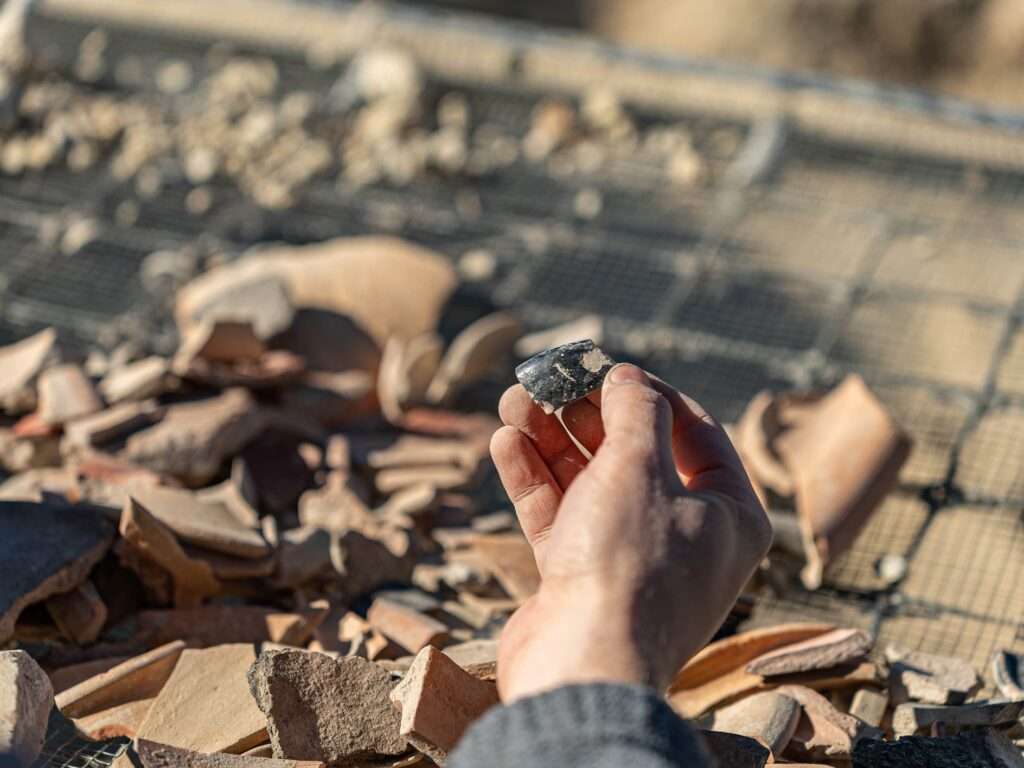ARCHAEOLOGICAL PROCESS
The excavations in the Cerro del Santuario were carried out to try to document the necropolis given the removal of the land undertaken by the owner of the property for agricultural conditioning. The N area of the hill was the most affected. In the summer of 1968, the MAN began the first excavation work on the W side of the hill, documenting 17 burials, whose grave goods were sent to the Archaeological Museum of Granada, as ordered by the Excavation Order. During the following winter and spring, the land was leased and then sold to patron Pere Durán Farell, who was interested in subsidizing the excavations, granting him ownership of the objects found by law. Once again, the excavation permit was obtained for the 1969 and 1970 campaign in which tombs 18 to 130 were discovered. The material was sent, by order of the General Commissariat, to the MAN, where the tombs were restored, drawn and photographed. pieces at the expense of Mr. Durán.
In 1971, the last excavation campaign was carried out, in which many of the tombs with the most spectacular grave goods were documented, such as 155, which contained the cinerary sculpture of the Lady of Baza. Tombs 131 to 183 were excavated. The excavations documented a medium-sized cremation necropolis that was used throughout the 4th century BC.
The tombs were classified into four types:
– Type A: The most frequent and distributed throughout the necropolis. It consists of a hole made directly in the ground, about 0.35 m. deep and 0.30 m wide, in which a ceramic urn with the ashes of the deceased is documented, covered with a plate and next to it, sometimes, there is a weapon or small glasses.
– Type B: They are small tombs, but made of adobe or square-shaped rammed earth and also covered by a few adobes, which sometimes form a pyramid-shaped superstructure. The trousseau is the same as in the previous group, although with decorated Iberian ceramic vessels.
– Type C: This group is made up of a series of cist tombs, very typical in this necropolis. The simplest form consists of a cist built with large slabs of local limestone.
– Type D: These are tombs whose infrastructure consists of a rectangular pit with a tendency to square shape excavated in the rock of the hill and with the grave goods deposited at the bottom.
Among all these tombs excavated in 1971, 44 years later it was discovered that tomb number 155 of the Cerro Santuario necropolis, where the Iberian sculpture of the Lady of Baza was found, was not destroyed as has been believed until now.
Between 2013 and 2015, work on the site resumed, under the responsibility of the CEAB. These works show that the large and medium-sized chamber tombs were more architecturally complex than had been considered. These usually have an entrance hallway, in some cases anterooms, and walls plastered with plaster, painted with red motifs. On the other hand, it has been shown that the great tombs had a long history, with constructive reforms and changes of function and ritual within them.
NEW VISION OF THE DEPOSIT
The CEAB researchers specify that the visualization of the necropolis has also changed from an important point of view: «In relation to the Roman construction, it is possible that we should associate with it the construction elements located at various times on the surface of the site. This is the case of what is known as the Egyptian gola, recovered near tomb 123 and which, in reality, must have been a Roman cymbal. In addition, there are several pieces of ashlar masonry in the Baza museum that can be related to this monument, and that present carved decoration of pilasters and rhomboidal lattices.
The latest findings of great scientific interest were achieved thanks to the conservation and musealization work that the Baza City Council is carrying out in the archaeological sites of the Iberian city of Basti and in the Cerro Santuario necropolis, to make them accessible through walking trails that They will tour the settlement and will have signage and observation points that will allow visitors to better understand how the Bastetan population lived more than 2,500 years ago.

ARCHAEOLOGICAL PROCESS AND RE-EXCAVATION 2023/2024
Geophysical mapping of the earth
In collaboration with the Andalusian Geophysical Institute, a geophysical survey of the virgin areas of the site has been carried out, using electrical and magnetic methods with georadar.
Re-excavation of tombs 43, 106 and 142.
Of the structures intervened in this campaign, three elements stand out. Tomb 43 is a medium-sized cist of stone slabs, with interior benches, to which an entrance hallway has been documented. Tomb 106 is another chamber tomb, from the oldest phase of the site, and therefore with a very simple structure, in which a red clay covering stands out. And tomb 142 is another chamber tomb, in this case with a very original structure consisting of a framework of adobe and wood, which supported a wooden roof over the chamber.”













Screening of landfills and waste dumps
In this campaign the last terrera from the 1968-1971 campaigns has been removed and screened. With this, the original profile and shape of the hill has been recovered, prior to the first archaeological interventions, and numerous ceramic, metal, stone and bone materials, discarded by ancient interventions, have been recovered. Among these materials, gold and silver earrings, necklace beads and vitreous buttons, bone textile pins, fragments of Roman inscriptions, and in general, a set of ceramics that illustrate the long chronological life of this site, which encompasses from the Late Bronze to the 7th-8th century AD.
Interpretation of the remains and grave goods found in the re-excavations.
One of the most novel aspects in the interpretation of Iberian funerary trousseau is the confirmation that the trousseau is personal, but rather a family offering, and that in the large chambers the repeated presence of tableware related to the consumption of alcoholic beverages and the libation, which usually consist of a bronze basin, to contain the liquid, plates, kylix or small jugs for serving the drink. This trousseau is kept inside the funerary chambers, and not in the city homes, because it has a sacred character.
Burying the tombs for conservation and subsequent work.
Once the documentation work was completed, the archaeological structures have been subject to a series of preventive conservation measures. Small defects in the buildings have been repaired; The plaster floors have been protected with absorbent vegetable paper and a layer of inert aggregates. In addition, they have been protected with anti-weed mesh and a powerful layer of soil from the site’s soil, which will allow the conservation of these remains for future musealization.
